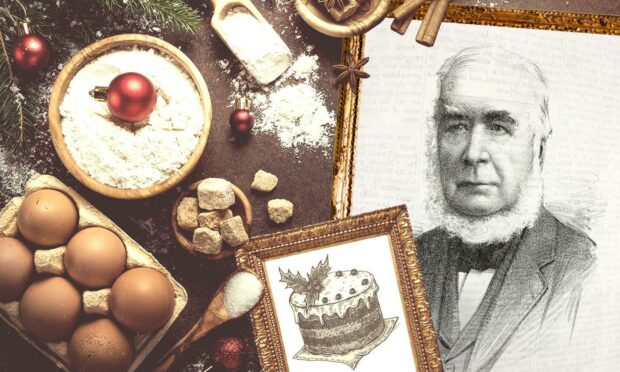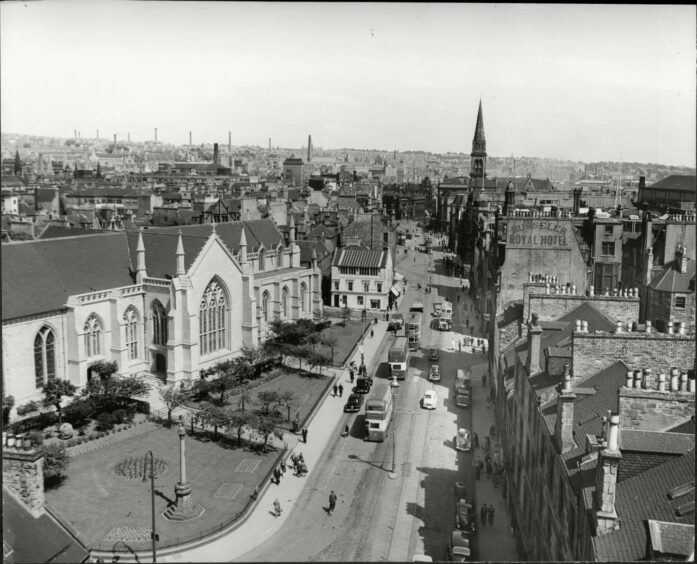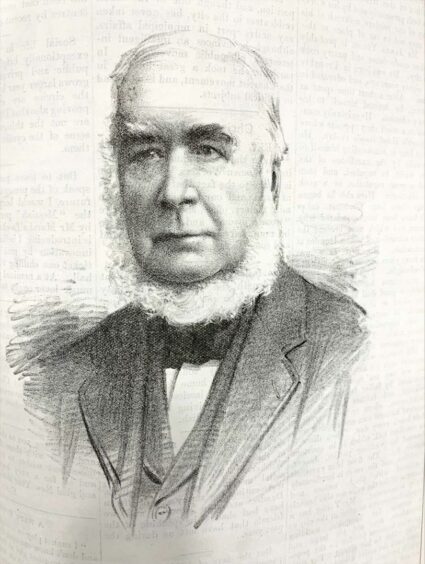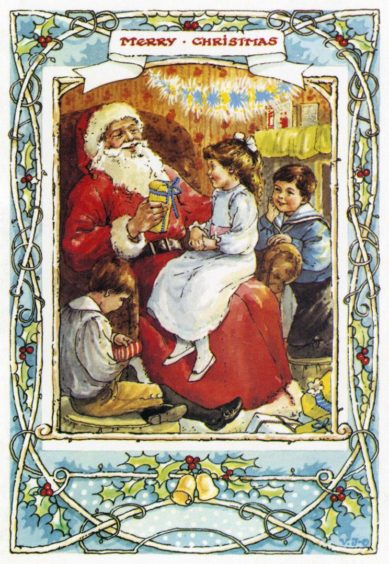A Christmas cake the size of a small truck sounds like the stuff of sweet dreams — but not in Dundee in the late Victorian era.
James Young from Broughty Ferry was the confectioner of a gigantic yearly yuletide creation at his shop in 84- 86 Nethergate, Dundee.
Young’s, where St David’s Hall is currently, displayed an ever-larger Christmas cake every year for half a century, eagerly anticipated by the populace.
It started in the 1850s at 56lb, and by 1901 it had grown to three tons, the size of a truck.
Each year it was vaunted as ‘the largest cake ever recorded’.
In December 1895 it was unveiled at 8ft tall and 2 tons 3cwt (4,745lb) in weight.
Mammoth production
The amount of eggs it required even appears to have caused a shortage in the area, as the Dundee Courier reported:
“The gigantic Christmas cake on view at Mr Young’s confectionery establishment in Nethergate has been attracting considerable attention during the past few days.
“Annually for forty years Mr Young has produced a cake unrivalled in size, and, season after season, the cake became larger and larger in dimensions and weight.
“The latest mammoth production is built in four storeys, the lower one covering an area of thirty-six square feet.
“The scarcity of eggs at the present time may to some extent be explained by the fact that no fewer than 9216 have been used by Young in the manufacture of the cake, the icing alone having required 2688.
“The other ingredients include 544 lbs. of butter, 544 lb of sugar, (missing figure)lbs. currants, 584 lbs. raisins, 336 lbs. mixed peel, 128 lbs. almonds, 1040 lbs. flour, and 6 cwts. of icing sugar.
“Great care and attention was paid to the mixing of the materials, and a very rich and delicious cake has been produced.
“Orders are now being booked, and the cake will be cut up on Tuesday of next week.
“Up till then, however, the huge production, which is decorated with holly leaves, numerous miniature flags, etc can be seen in Mr Young’s premises at 84 Nethergate.”
The cake could be ordered and sent to ‘every part’ once it was cut up.
An annual institution for Dundonians
It was an institution Dundonians looked forward to every year until the business was sold and the freemasons took over the building in 1905.
Poems were regularly penned to Young’s Christmas cake in the local press.
In summer, Young’s would delight with its ice creams, created with the help of large blocks of ice imported from Norway.
Mr Young held five or six hundred tons of ice in storage in Bell Street, and would sell it around the area: “Delivered in Town and Country at extremely Low Price.”
He was a stalwart advertiser in the local press, often running a few lines to remind Dundonians of his dining rooms in 84-86 Nethergate, ‘opposite the Old Steeple’.
In 1892, he ran frequent small ads to “Remind his Customers and the Public that in Connection with his Long-Established Confectionery and Restaurant Business, he has lately added a LARGE and COMMODIOUS HALL, suitable for WEDDING, PRIVATE and all SOCIAL PARTIES.”
The dining room supplied an average of 100 businessmen a day with their lunch, while the two tea rooms were extensively patronized by ladies on shopping expeditions, wrote the Piper O Dundee of 1896.
“Then there is the excellent hall, which is in constant demand… the floor is in excellent condition, and the room is handsomely furnished with plush settees and lounges, whilst the walls are also beautifully ornamented.”
A citizen’s arrest
But life wasn’t always a piece of cake at Young’s.
In October 1898, while the Young family were in the country, the shop’s manager Mr McNab carried out a citizen’s arrest on the man who had broken into the Young apartments and ransacked a wardrobe, making off with £40 (around £5,000 in today’s money) worth of items including a sealskin jacket and gold brooch.
The man had gained entry by coming into the shop offering hyacinth bulbs for sale.
After being sent away he had made his way onto the roof of the building, and servants later saw him leave ‘carrying a bundle.’
The next day Mr McNab bumped into the man, and ‘grasping him by the collar of his coat, charged him with the crime, lodged him in one of Mr Young’s cellars and sent for the police. The man was later taken in charge and lodged in the Central Police Office.’
James Young died in April the following year.
Obituary
“After a short time spent in the occupation of gardening he devoted himself to the business of confectioner and pastry cook,” wrote the Dundee Courier.
“He started business in a small shop opposite where the Queen’s Hotel now stands, where he was not long in commending himself to the public by the excellence of the articles which he produced, and very soon, gained a wide reputation.
“One particular production was the large Christmas cake, which has ever been the feature of that season in Mr Young’s shop.
“The first of these was made forty years ago and weighed 5cwts, but the one made last year weighed as much as three tons.”
The obituary gives us a glimpse into Mr Young’s personality.
“Mr Young, from Broughty Ferry, who was in his 83rd year, was of a retiring disposition, and, though one of the oldest citizens, had never taken any prominent part in the affairs of the city, was nevertheless a keen observer, and was well versed in political affairs.”
James Young lost both his sons, James and John from tuberculosis within months of each other in 1876. James was 29, John 27 and both were master confectioners.
This heartbreak meant he had no-one to hand the business on to in his later years.
By 1904, Mr G Johnston of Murraygate had acquired the business — and the right to make the famous Christmas cake, which though still huge, it had shrunk considerably to a mere ton.
Fit for a king
“The ‘monstre’ cake as made by the late James Young, and this year, in all the glory of iced sugar, banners and bon-bons, it is set out in Mr Johnston’s shop in 5 Murraygate,” the local press reported.
“Already portions are speeding over land and sea to give an Indian or African tea table the flavour of ‘Bonnie Dundee’.
“It is four feet square and eight feet high, and it consists of 320lb of butter, 320lb of sugar, 320 dozen of eggs, 900lb of fruit and 600lb of flour.
“Quite a respectable Christmas cake to set before a King!”
It sold at 1 shilling per pound.
We have left no stone unturned to find a photograph of any of the giant cakes made by Young’s. Perhaps in your attic, you have family albums dating back to the late 19th/early 20th century? Could there be a ‘monstre’ cake within?
If so please let us know! Email: susy.macaulay@pressandjournal.co.uk













